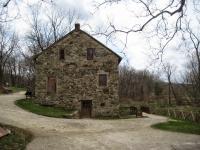Designated a National Historic Landmark in 2005, the Mill at Anselma has a history spanning over 250 years. Some of its original mechanisms are still in place along with other equipment used from the late 1700s to the early 1900s. As a result, you can see some of the progression of the milling industry in the mill’s moving parts. The best part is that the mill still functions today!
The Mill at Anselma, a water-powered gristmill, was built on Pickering Creek in 1747 by Samuel Lightfoot in what is today Chester Springs, Pennsylvania. His family continued to own and operate the mill into the early 19th century, when they sold it. After going through a few other owners, a man by the name of Elias Oberholtzer purchased the mill in 1859. Elias’ son, John, took over the running of the mill, and he and his wife, Sara Louisa Vickers, raised their family there. Sara was a poet and wrote often about the mill and the land.
Radiant day is slowly fading,
And the evening calm and still,
Gazing through the oak and willow,
Stoops to kiss the ancient mill.
Listen to the damsel dancing,
To the jig of feed and flour.
And the water-wheel revolving
With a dashing constant power.
There is music in the rattle
Of the tinkling wheat that falls
In the hopper, as the miller,
Stops to heed the gristman’s calls.
Yes, I love this shaded building,
Love the flowing stream and flowers,
Love to hear the busy clatter,
On the lingering summer hours.
More than all, I love the miller,
For his sake, I love the rest.
Of this world and its enchantments
I adore his as the best.
Of these twilights I would weary
If his voice came not to cheer,
And this mill-life would grow dreary
If my darling were not here.
- Sara Louisa Vickers Oberholtzer, 1873

First floor interior image of the Mill at Anselma
In 1871, John Oberholtzer suffered an injury while trying to free the water wheel from ice. After his injury, he focused on bringing more business to the local area, building a general store, and helping to convince the Reading Railroad to create a short line through the Pickering Valley connecting Phoenixville with Byers in Chester County. The Pickering Valley Railroad opened in September 1871 with the tracks running right through the mill’s back yard. At first, the train stop was called “Cambria,” as that was the name of the area around the mill at the time, but in 1886 the train stop was re-named “Anselma” to cease confusion with another station that was also called Cambria.

Anselma Station on the Pickering Valley Railroad, 1920
After the introduction of the rail line through Anselma, the surroundings prospered and a post office was built. The mill’s ownership changed hands again and by 1886 was owned by Allen Simmers. Simmers made many improvements to the mill, including replacing the wooden water wheel with a steel one made by the Fitz Water Wheel Company of Hannover, Pennsylvania around 1906. Simmers ran the mill successfully until the advent of the automobile made commercial rail transportation less desirable and the invention of portable gristmills eliminated the need to travel for the purpose of milling flour.

In 1919, Simmers sold the mill to Oliver Collins. Even though the milling business was in decline, Collins was creative and thought of ways to use the water wheel for money-making endeavors beyond that of milling. In addition to running a gristmill, Collins had a saw mill, cider press, metal working shop, barbershop, and lawnmower repair shop. The barbershop and lawnmower repair service were housed inside the mill and his barber’s chair is still in his upstairs office, where everything remains pretty much as he left it. Thanks to Oliver’s ingenuity, he was able to keep the mill up and running until his death in 1982.

Oliver Collins, the last miller at Anselma
The Mill at Anselma Preservation and Educational Trust (MAAPET) runs the mill and cares for the property today, offering the public a chance to see the mill in action, learn about its history, and even purchase a variety of flour ground on-site. MAAPET also has some archival materials relating to the milling families of Anselma and the history of the surrounding area including photographs of the Anselma District from the 1920s, Allen Simmers daybooks and account books of Oliver Collins, oral histories, and blueprints. In addition to these materials, MAAPET has some materials relating to the mill and surrounding area from Eleanor Morris, who was a local conservationist, the co-founder of the French and Pickering Creeks Conservation Trust, and a founding member of MAAPET.

Page from Oliver Collins' account book, 1943
If you are in need of some preservative-free fresh ground flour, pop over and visit the Mill at Anselma and see why the millers really did enjoy their daily grind!
See all finding aids for Mill at Anselma Preservation and Educational Trust

